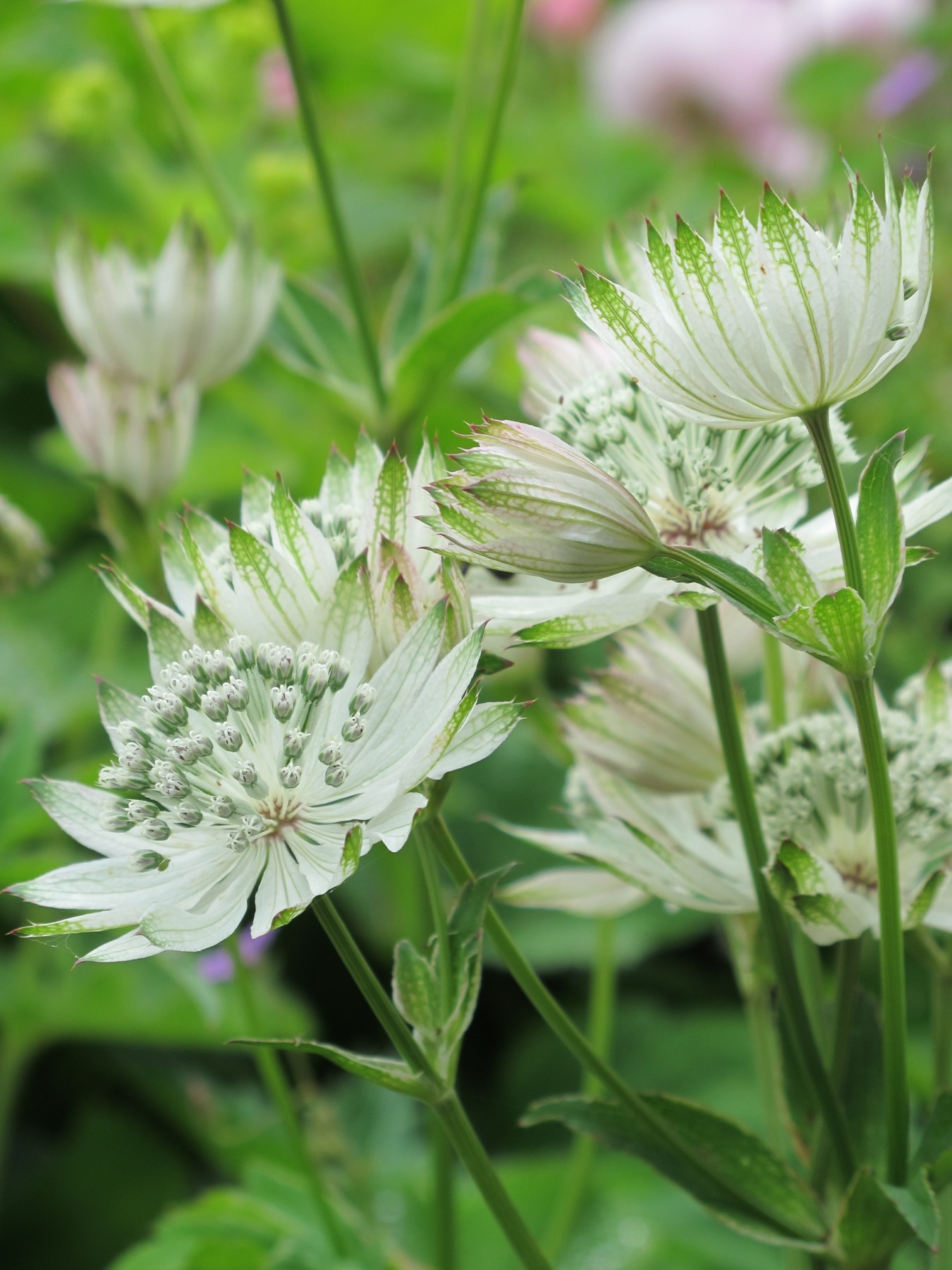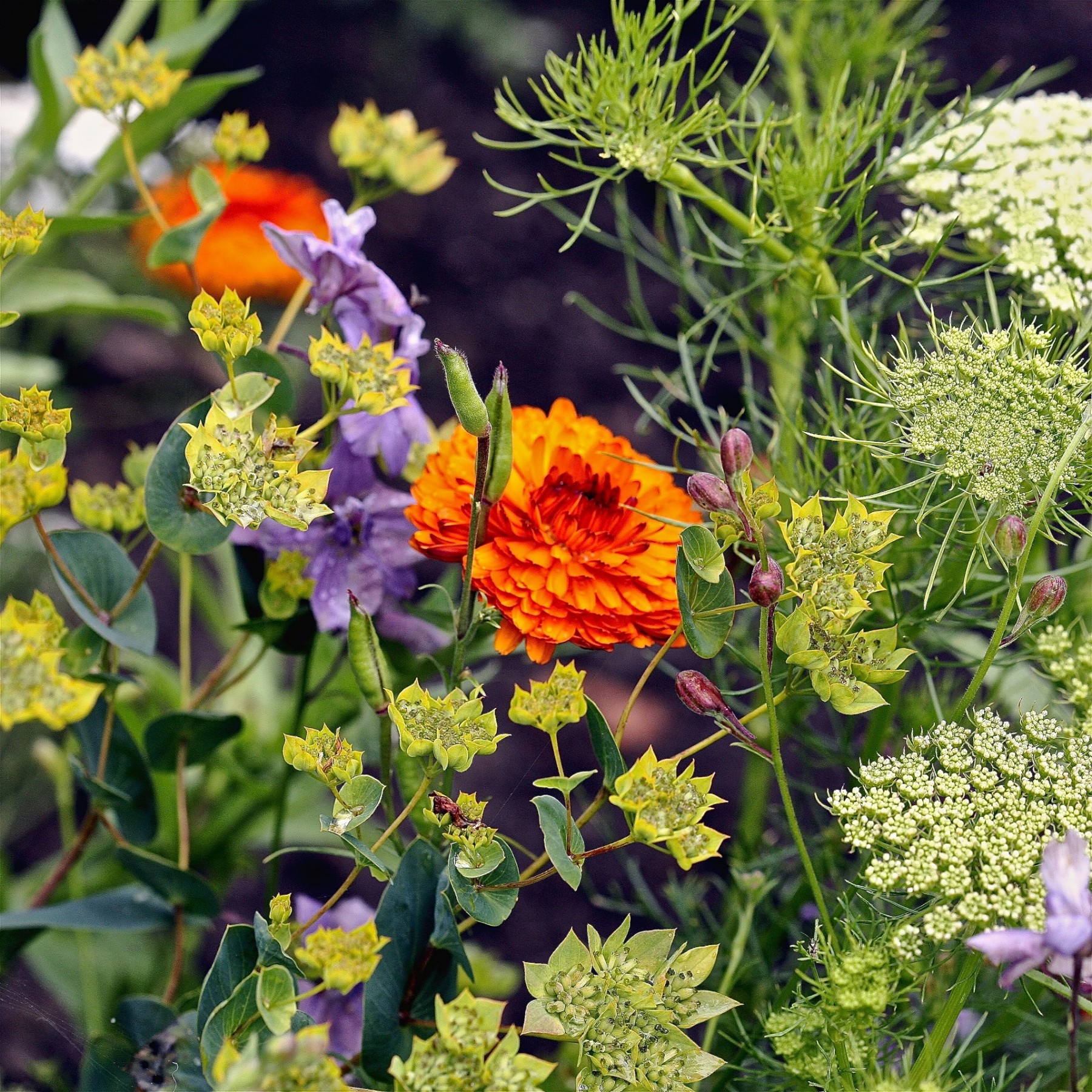
In recent times the modern planting style has been airy and light, dare I say as frothy as badly drawn beer. It’s led to an explosion of umbels, a term short for umbellifers, in show gardens and gardens alike. These plants have an arrangement of tiny, nectar-rich flowers arranged in a variety of ways. The most obvious member is cow parsley (Anthriscus sylvestris) and this has a loose arrangement of white flowers arranged on radiating spikes resembling an upturned umbrella. There’s a dark-leaved one popular with gardeners, called ‘Ravenswing’, and 50% of the seedlings are dark-leaved and the rest green. The difference shows in the first leaves and demands selection there and then, so it’s an on-your-knees job and that’s always good for sorting out any woes.
Some umbels have much shorter radiating stems so the arrangement is rather like a pincushion and one of the common names for Astrantia is Hattie’s pincushion. The star of bracts round the tiny flowers is long-lasting and highly attractive and there are sultry forms such as ‘Hadspen Blood’ and paler ones like ‘Buckland’. The candy-pink ‘Roma’ is sterile so the flowers last a long time. Go a step further towards even more compression and you get an eryngium, or sea holly. Many will find it hard to believe that sea hollies are umbellifers because those tight thimbles are worlds away from the foamier cow parsleys.
Umbellifers are not only good looking, they’re extremely insect-friendly plants because at the base of each individual flower there’s a nectary containing concentrated nectar. Certain insects prefer to drink from different umbellifers. The tight thimbles of some eryngiums, for instance, are loved by bumblebees particularly buff-tailed bumblebees ( Bombus terrestris) who flock to E. giganteum. The flowers seem to suit their shortish tongues, which are about one fifth of an inch in length, and the blue or silvered flowers also attract smaller butterflies such as ringlets.
Astrantias are much daintier affairs and smaller hoverflies, limited in their choice of flower by having extremely small mouth parts, adore them. More domed umbels flowerheads attract hoverflies of all sizes and large flies. Some umbels have developed green flowers with a slightly unpleasant smell just to attract larger flies. Common angelica ( Angelica archangelica) is such a plant, as is the shrubby umbellifer Bupleurum fruticosum , the Giant fennel ( Ferula communis) and the late-flowering New World eryngiums E. pandanifolium.

These visiting creatures are all very good pollinators and the end result is plenty of seeds. The knock on effect of lots of seeds being produced is that some umbellifers are fairly short-lived. There are one-year wonders, or annuals, and two-year affairs known as biennials. Some are monocarpic, or have monocarpic tendencies, which means they flower and die like operatic divas with consumption. Others have long tap roots, so are difficult to divide. Carrots and parsnips have delicious tap roots because this is mostly an edible family with a few deadly villains. The most toxic of all is deadly hemlock ( Conium maculatum) a plant with smooth, spotty stems that smell of mice. Socrates famously died after drinking a concoction.
Many umbellifers have to be seed-raised for a variety of reasons, but if sown in March and April they tend to make small, miserable plants. Sown now, at the start of the year, you’ll get larger plants that flower earlier and hopefully lots of seeds. Many serious gardeners so even further and sow their umbellifers in autumn, to ensure even bigger and better plants. If you’ve got the discipline this the best time, although it generally passes me by.
You might imagine that lots of seeds means lots of seedlings in the garden, popping up all on their own in all the right places. Some umbellifers, such as cow parsley, sweet Cicely ( Myrrhis odorata) and most astrantias, do self seed willingly, but they can prove to be a nuisance especially on lighter, sandier soils. However lots of the most desirable umbellifers come from the Mediterranean and they do not self-seed, if left to their own devices in our climate, because they need warmer temperatures to germinate. We don’t know what warmth is, here in Cold Aston!
What to Sow Now
My favourite annual umbellifer is called the white lace flower or Orlaya grandiflora and the seeds are widely available. The bright-white flower heads have the usual arrangement of tiny white flowers, but these are surrounded by showy ray florets giving this flowerhead a lacecap look. It’s a Mediterranean plant with greyish foliage and I once saw masses on the outer edges of an olive grove in Crete. The oval light-brown seeds have hooked edges that cling to clothing and animals and they resemble strange insects. In Crete it self seeds readily, but I have raised and grown huge plants here and allowed the seeds to fall on the ground with virtually no success. One lone seedling came up last year. So gather the seeds every year and get them in as soon as you can, under glass. Chiltern Seeds (www.chilternseeds.co.uk) offer good value, generally undercutting the competition and giving you slightly more.
I’ll also be sowing Ammi seeds and the whole world fell in love with Ammi majus, a May-flowering white umbel often featured in Chelsea show gardens. It’s an etiolated version of cow parsley, somewhat floppier in habit. ‘Graceland’ has been selected for its longer stems and this is a popular cut flower that’s grown commercially. It’s super with dark sweet peas. However I prefer the more-erect, later flowering A. visnaga for its feathery foliage and flatter heads of flower that start green, turn to white and then dry to parchment. It resembles a wild carrot, but doesn’t set seeds for me so this annual has to be bought every year. There is a refined selection called ‘Green Mist’ and, if you do miss the boat when it comes to sowing, Hardy’s Cottage Garden Plants often sell this and other umbellifers.
There are perennial cow parsley impostors and Crocus wooed the Chelsea Flower show with Baltic cow parsley, Cenolophium denudatum several years ago. In the garden, without the benefit of heated greenhouses, it will flower in midsummer and not May. If you do want an easy perennial umbellifer that will flower in spring the blue-pink heads of Chaerophyllum hirsutum ‘Roseum’, a form of the hairy chervil, are good with purple alliums such as ‘Purple Sensation’. I’ve found it amenable in all my gardens, different though they are.
I also love the compact summer-flowering pale-pink umbels and oh-so-fine foliage of Seseli hippomarathrum. This is delightful among roses because it has a habit of winding up through things. Try Special Plants for a good dusky form (www.specialplants.net ) and Derry Watkins sells seeds and plants. Although I’d try to get a flowering plant, because some are a mucky white like the Best Beloved’s trainers.

If you’re impressed by long words, or like to name drop, the most verbose umbellifer is definitely Molopospermum peloponnesiacum which is plant with attitude – and yes I did have to look it up! This architectural umbel grows to great effect at Gravetye Manor and the lovely Head Gardener, Tom Coward, gave me a plant he’d dug up from the border, They dig them up because this Greek plant needs sharp drainage to survive a British winter and Gravetye’s Wealden clay is sticky. Sadly it didn’t overwinter for me, despite me visiting the huge pot in the greenhouse often. So I’ve had to content myself with another handsome umbellifer. It was described as the Queen of the Umbellifers by the famous E. A. Bowles, is Selinum wallichianum which has been in my garden for over ten years. Native to the Himalayan foothills from Kashmir to Bhutan it combines vivid-green lacy, foliage with creamy high summer flowerheads on a four-foot high plant with straight stems. It’s star attraction are the bracts and sheaths, which come in pink-purple. It loves a cold winter, followed by a warm spring and a wet summer and, if luck conspires to produce the correct combination of seasonal conditions, it’s a titan. In other years it’s still magnificent.
I have a love hate relationship with my favourite umbel, Eryngium giganteum or Miss Willmott’s ghost. I love the steely structure of branching silver stems, although my damp climate does not always produce enough steel. The jagged silvery bracts and thimble, hardly ever without a bee, draw me out again and again in June and July. However I get too many seedlings popping up, despite the fact that I remove most of the heads before they brown and release seeds. They are impossible to weed out and have a habit of infiltrating prize plants such as my snowdrops. For all that I still adore it and at least this is one umbel I can leave to its own devices. The rest I’m going out to sow now!



